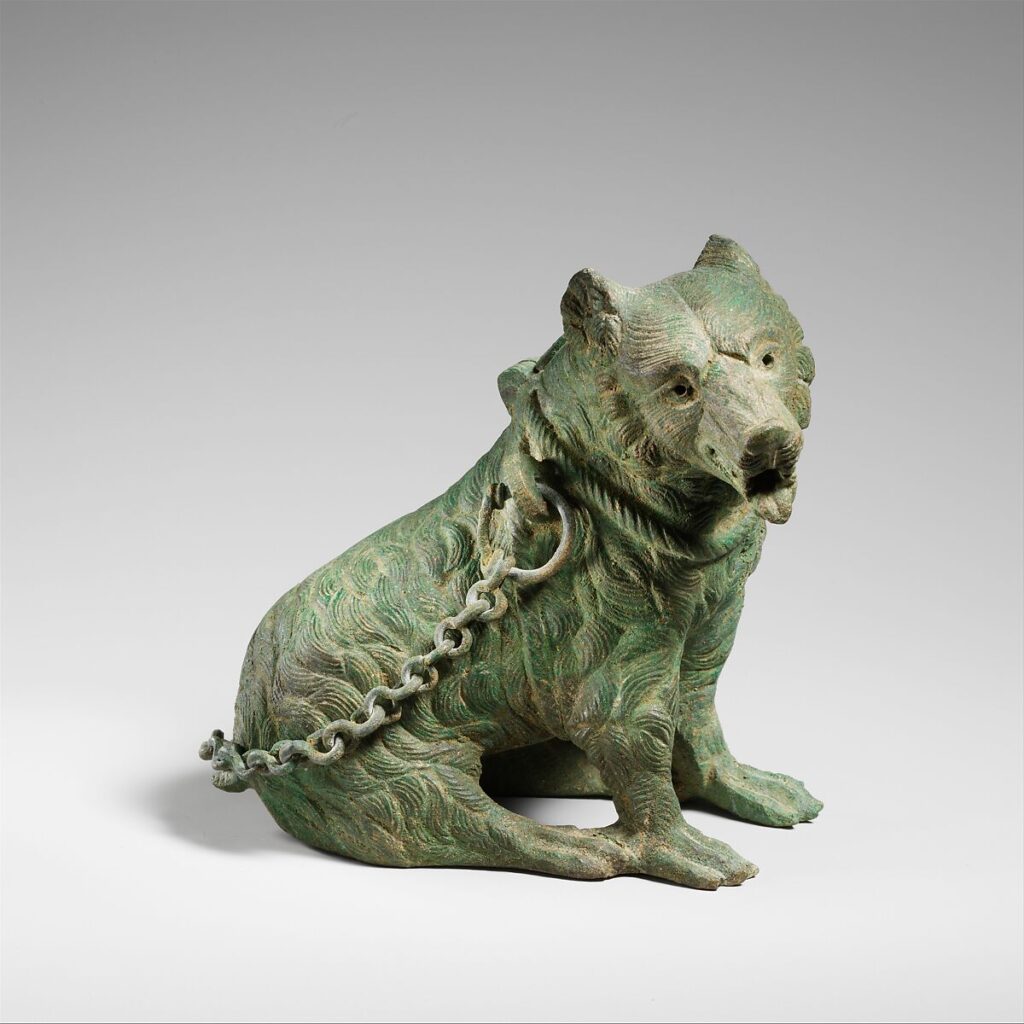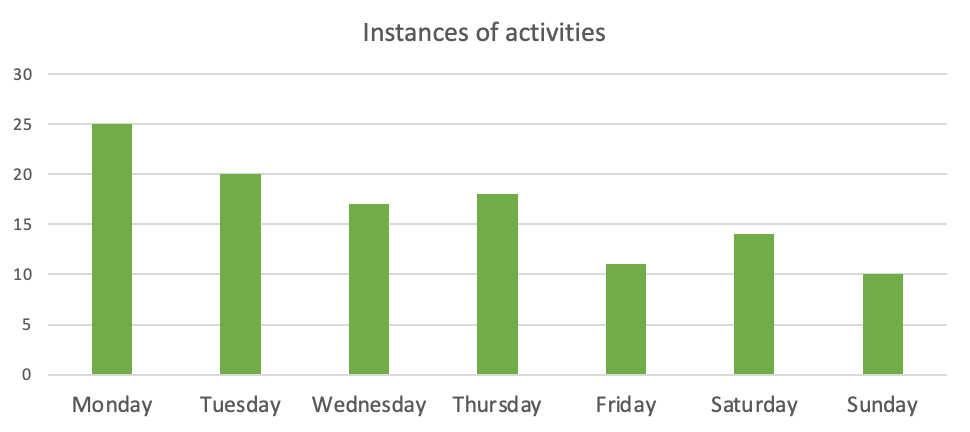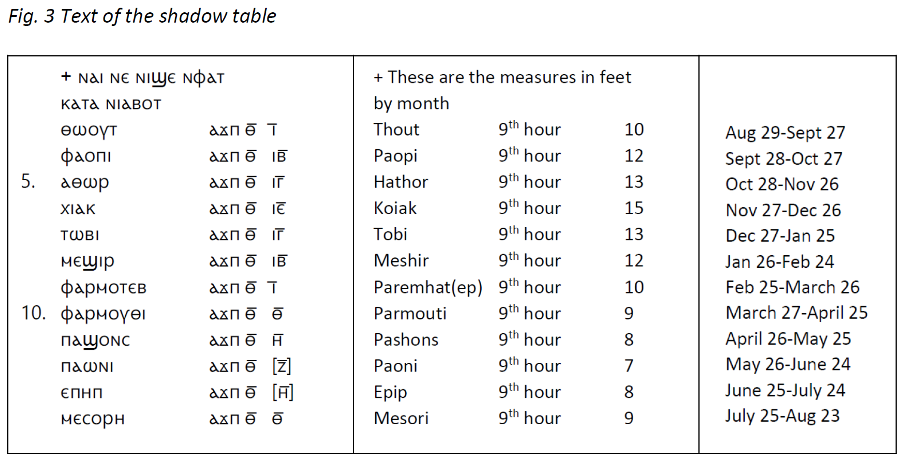In Sahidic, the main variant of Coptic in late antiquity and the early Islamic period, there are three incomplete sets of names for days of the week (Table 1). Words for Sunday, Friday and Saturday were adopted from the Greek version of the Bible, whereas the days from Monday to Friday were numbered and written in full in Coptic. In the 1940s and early 1950s, the Austrian Coptologist Walter C. Till gradually identified a third set of names that refers to “fasts” and “intervals”, but until recently, scholars still struggled to interpret these. When writing his PhD dissertation (published in 2020), Frederic Krueger rediscovered both their meaning and Till’s findings. As all these publications are in German, and not all of them are available online, it is good to discuss Coptic expressions for the days of the week in a more accessible medium. In addition, the Lived Time project offers the opportunity to examine the use of different sets of names in particular types of texts and regions.
The names of Biblical origin include:
- ⲧⲕⲩⲣⲓⲁⲕⲏ, “the Lord’s day”, for Sunday (Κυριακή, short for ἡ Κυριακὴ ἡμέρα; Rev. 1:10);
- ⲡⲥⲁⲃⲃⲁⲧⲟⲛ, “the Sabbath”, for Saturday (τό Σάββατον, from the Hebrew Shabbat, “rest”; Ex. 20:10);
- ⲧⲡⲁⲣⲁⲥⲕⲉⲩⲏ, “the Preparation (day)” for the Sabbath, for Friday (παρασκευή; Luke 23:54).
The Coptic versions are preceded by a definite article, which is a ⲧ- before the feminine nouns, and the masculine article ⲡ- before ⲡⲥⲁⲃⲃⲁⲧⲟⲛ. Sometimes, ⲡⲥⲁⲃⲃⲁⲧⲟⲛ means “the week”.
The numerical names start with Sunday as the first day of the week: as the seventh day of Creation, on which God rested, was a Saturday, Creation must have started on a Sunday. Monday is ⲡⲉⲥⲛⲁⲩ, “(day) two”, Tuesday ⲡϣⲟⲙⲛ̄ⲧ, “(day) three”, Wednesday ⲡⲉϥⲧⲟⲟⲩ, “(day) four”, Thursday ⲡϯⲟⲩ, “(day) five”, and Friday ⲡⲥⲟⲟⲩ “(day) sixth”. These words consist of a Coptic cardinal number and the definite masculine article ⲡ-/ⲡⲉ-. Sometimes, the numerical names are spelled with ⲙⲉϩ-, the prefix to ordinal numerals, from ⲡⲙⲉϩⲥⲛⲁⲩ, “the second (day)”, for Monday, to ⲡⲙⲉϩⲥⲟⲟⲩ, “the sixth (day)”, for Friday.
Walter Till played a significant role in establishing the third set of names. When publishing Coptic farmers’ almanacs, collections of calendrical and meteorological omens used for planning agricultural activities, he discovered that ⲧⲕⲟⲩⲓ ⲛ̄ⲛⲏⲥⲧⲓⲁ, “the little fast”, and ⲧⲛⲟϭ ⲛ̄ⲛⲏⲥⲧⲓⲁ, “the great fast”, indicate Wednesday and Friday respectively (1943). ⲧⲛⲏⲥⲧⲓⲁ ϣⲏⲙ, “the little fast”, and ⲧⲛⲏⲥⲧⲓⲁ ⲱ (or ⲟⲩ), “the great fast”, are attested as well (1947). These expressions refer to the early Christian tradition to fast every “fourth day” to remember Jesus’ betrayal by Judas,[1] and every Friday to remember his crucifixion (Didascalia v. 13), two weekly fasts that are still observed by the Coptic Orthodox Church. Till surmised that Thursday was ⲡⲟⲩⲱϣ ⲛ̄ⲧⲙⲏⲧⲉ, “the interval in between”, or just ⲡⲟⲩⲱϣ, “the interval” (1947). His hypothesis is confirmed by a Sahidic lectionary fragment from Aswan (tenth century?), which also demonstrates that the hitherto unclear expressions ⲡϣⲟⲣⲡ ⲛ̄ϩⲟⲟⲩ ⲛ̄ⲟⲩⲱϣ, “the first interval day”, and ⲡⲙⲉϩⲥⲛⲁⲩ ⲛ̄ϩⲟⲟⲩ ⲛ̄ⲟⲩⲱϣ, “the second interval day”, refer to Monday and Tuesday (ed. Drescher 1951). Till discussed these alternative names in a festive volume (1953), and included them in the revised edition of his Koptische Grammatik (1961).
A quick survey for the Lived Time project reveals the text types and regions in which the expressions for week days appear (Table 2). Apart from the documentary texts, most examples postdate late antiquity. Interestingly, the day of the week is never included in dating formulas in Coptic contracts, which indicates that they were not considered relevant for calendrical purposes. In funerary inscriptions they are rare as well, appearing only in two epitaphs from the Monastery of St Jeremias at Saqqara, which refer to Thursday and Sunday by Greek numerical names written in digits: ἡ(μέρας) ε, “day 5” (AD 787), and ἡ(μέρας) α, “day 1” (AD 806).
As for the names of Biblical origin, ⲡⲥⲁⲃⲃⲁⲧⲟⲛ and ⲧⲕⲩⲣⲓⲁⲕⲏ indicate Saturday and Sunday in all text types. ⲧⲡⲁⲣⲁⲥⲕⲉⲩⲏ only occurs in a homily and in the lectionary from Aswan, which records no less than three words for Friday, as the three scribes who compiled it used different words.
Coptic numerical names are rare as well: they are only found in the lectionary from Aswan (ⲡⲙⲉϩⲥⲛⲁⲩ–ⲡⲙⲉϩⲥⲟⲟⲩ), and in a note in a literary manuscript from the White Monastery near Sohag (ⲡⲉϥⲧⲟⲟⲩ and ⲡⲥⲟⲟⲩ).
The examples for “the little fast” and “the great fast”, on the other hand, are more numerous. The spellings with ⲕⲟⲩⲓ and ⲛⲟϭ appear in a letter from the Hermopolite region, a Coptic farmers’ almanac, a literary manuscript, and the lectionary from Aswan. These attestations do not point to a particular region or period, unlike ⲧⲛⲏⲥⲧⲓⲁ ϣⲏⲙ and ⲧⲛⲏⲥⲧⲉⲓⲁ ⲟⲩ, which are found in monastic / ecclesiastic correspondence from early seventh-century Western Thebes. Some letters were addressed to the hermit Epiphanius (ca. 615–620), the leader of a hermitage, and to Bishop Pesynthios of Koptos, who stayed at this hermitage in the 620s. The expressions were used by monks, clergymen and laymen.
Expressions with ⲡⲟⲩⲱϣ for Thursday are recorded in different kinds of sources from all over Egypt: letters from Western Thebes, an inscription at the Monastery of St Jeremias at Saqqara, a literary text from a monastery near Edfu, and the lectionary from Aswan. The “first interval day” and “second interval day” for Monday and Tuesday appear in letters from Western Thebes (the hermitage of Epiphanius) and in the lectionary from Aswan, where “first” and “second” are replaced by digits (ⲁ ⲛⲟⲩⲱϣ and ⲃ ⲛⲟⲩⲱϣ).
In short, a quick survey reveals that ⲧⲕⲩⲣⲓⲁⲕⲏ and ⲡⲥⲁⲃⲃⲁⲧⲟⲛ are the standard words for Sunday and Saturday, whereas there are no less than five different words for Friday (ⲧⲡⲁⲣⲁⲥⲕⲉⲩⲏ, ⲡⲥⲟⲟⲩ, ⲡⲙⲉϩⲥⲟⲟⲩ, ⲧⲛⲟϭ ⲛ̄ⲛⲏⲥⲧⲓⲁ and ⲧⲛⲏⲥⲧⲓⲁ ⲟⲩ). In general, numerical names for Monday to Thursday mainly appear in lectionaries, and alternative names for Monday to Friday in letters. Most examples of alternative names come from a mixed monastic / ecclesiastic milieu in Western Thebes (early seventh century), where monks, clergymen and laymen alike used the expressions ⲧⲛⲏⲥⲧⲓⲁ ϣⲏⲙ and ⲧⲛⲏⲥⲧⲉⲓⲁ ⲟⲩ, “the little fast” and “the great fast”, for Wednesday and Friday respectively. By contrast, ⲧⲕⲟⲩⲓ ⲛ̄ⲛⲉⲥⲧⲓⲁ and ⲧⲛⲟϭ ⲛ̄ⲛⲏⲥⲧⲓⲁ, which have the same meanings, appear in sources from different parts of Egypt and in different types of texts. Interestingly, Biblical, numerical and alternative names can also be found together in a single source: the lectionary from Aswan, which was compiled by three scribes, who used different expressions. Further research is likely to reveal more (late) examples of names of week days in lectionaries and literary texts.
Renate Dekker
Relevant literature
- Till, W.C. “Bemerkungen zu koptischen Textausgaben. 7–8”, Orientalia. Nova Series 12 (1943), 328–337, particularly 330–332.
- Till, W.C. “Neue koptische Wochentagsbezeichnungen”, Orientalia. Nova Series 16.1 (1947), 130–135.
- Till, W.C. “Die Wochentagsnamen in Koptischen”, Publications de l’Institut d’études orientales de la Bibliothèque Patriarcale d’Alexandrie 2 (= Tome commémoratif du millénaire de la Bibliothèque Patriarcale d’Alexandrie), Alexandria 1953, 101–110.
- Till, W.C. Koptische Grammatik, Leipzig 1961 (revised version; first edition: 1955), 88–89.
[1] Two interesting things come into play here. First, the day did not start at sunrise, but in the night before, just as “there was evening, and there was morning – the first day” (Gen. 1:5). Second, according to the Didascalia (preserved in Syriac and Latin), the Last Supper and Jesus’ arrest took place on Tuesday eve (that is, Wednesday), Jesus remained in detention on Wednesday, and was handed over to Pilate on Thursday. In general, the Eastern and Western Church traditions remember Judas’ plan to betray Jesus on Wednesday, the Last Supper and Jesus’ arrest on Thursday, and his delivery to Pilate on Friday.






